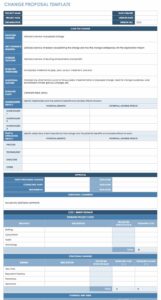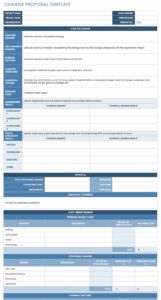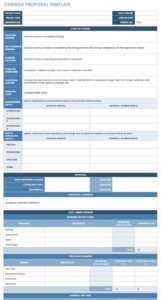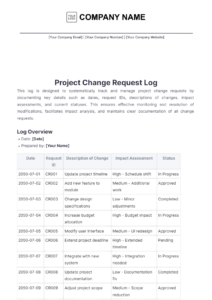Utilizing such a system offers numerous advantages, including improved communication among stakeholders, better version control, and enhanced transparency throughout the modification lifecycle. It facilitates organized impact assessments, prioritizing changes, and monitoring progress towards implementation. This, in turn, minimizes disruptions and promotes successful project delivery.
This article further explores the key components, practical applications, and best practices associated with managing modifications effectively.
Key Components
Effective management of modifications relies on a well-structured documentation process. Several key components ensure comprehensive recording and tracking.
1. Unique Identifier: Each entry requires a unique identifier (e.g., a sequential number) for easy referencing and tracking.
2. Requestor Information: Details about the individual or team requesting the change, including name, department, and contact information.
3. Date of Request: The date the modification was initially requested.
4. Description of Change: A clear and concise explanation of the proposed modification, including its purpose and scope.
5. Justification: The reasoning behind the requested change and its potential benefits.
6. Priority Level: An assigned level of importance (e.g., high, medium, low) to guide implementation sequencing.
7. Status: The current stage of the change request (e.g., submitted, approved, implemented, rejected).
8. Implementation Date: The planned or actual date of implementation.
These elements provide a robust framework for managing the entire lifecycle of requested alterations, from initial submission to final implementation and closure.
How to Create a Change Request Register Template
Creating a standardized template ensures consistent handling and facilitates efficient tracking of modifications. The following steps outline the process of developing a practical and effective template.
1. Determine the Tool: Select an appropriate tool for creating the register. Options include spreadsheet software, database applications, or dedicated project management software. The chosen tool should allow for easy data entry, sorting, and filtering.
2. Define Columns: Establish columns representing key data points. Essential columns include a unique identifier, requestor information, date of request, change description, justification, priority level, status, assigned personnel, implementation date, and any project-specific requirements.
3. Establish Naming Conventions: Implement clear naming conventions for requests to ensure consistency and facilitate searchability. This might include prefixes, project codes, or date formats.
4. Develop a Version Control System: Implement a system for managing template versions to track revisions and ensure stakeholders utilize the most up-to-date version. This can involve version numbering or date stamping within the template itself.
5. Define Approval Workflow: Clearly outline the approval process, specifying roles and responsibilities for reviewing and authorizing change requests. This may involve incorporating designated approval fields within the template.
6. Training and Communication: Provide training to all stakeholders on using the template correctly. Clear communication about the process ensures consistent application and accurate data capture.
7. Regular Review and Refinement: Periodically review the template’s effectiveness and make necessary adjustments. This ensures the template remains relevant and continues to meet evolving project needs.
A well-designed template, coupled with proper training and consistent usage, provides a robust framework for managing modifications, leading to better project outcomes.
Effective management of modifications is crucial for successful project delivery and organizational agility. A structured approach, facilitated by a well-designed documentation system, provides the necessary framework for logging, tracking, and controlling requested alterations. Key components, including unique identifiers, clear descriptions, and defined approval workflows, contribute to a comprehensive and transparent modification process. Implementing a standardized template, coupled with appropriate training and regular review, ensures consistent application and maximizes the benefits of this essential project management tool.
Organizations seeking to improve project outcomes and adapt effectively to evolving needs should prioritize the implementation and consistent utilization of such a system. This proactive approach minimizes disruptions, enhances communication, and ultimately contributes to a more controlled and successful project lifecycle. Embracing standardized procedures for managing modifications fosters a culture of continuous improvement and positions organizations for greater success in dynamic environments.



